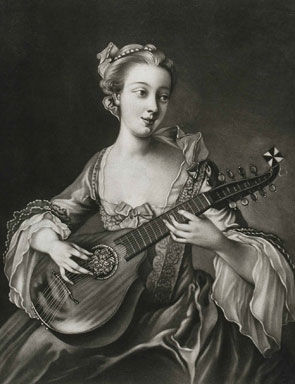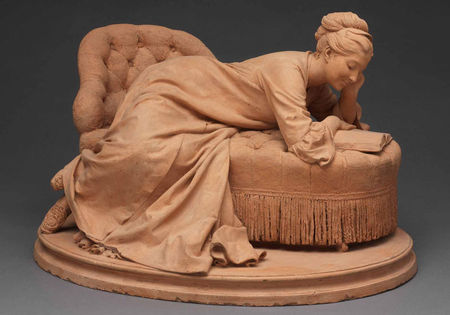'Dalou in England: Portraits of Womanhood, 1871-1879' @ Yale Center for British Art
Richard Houston after Philippe Mercier, Domestic Amusement: Playing on the Guitar, ca. 1760, mezzotint, Yale Center for British Art, Paul Mellon Fund.
NEW HAVEN, CT.- In 1871, French sculptor Jules Dalou (1838-1902) was exiled from France for his leftwing connections. A member of the Paris Commune, a radical group that briefl y rebelled against the French government, Dalou was forced to flee to London just as he was establishing himself as a successful sculptor. He lived in London for nine years, creating portrait sculptures and scenes of domesticity seemingly at odds with his politically progressive reputation. Intriguingly, he concentrated on sculpting the figure of the seated woman to the exclusion of almost any other theme.
A contemporary of Rodin, Dalou is best known for his large-scale national monuments that can be found in key sites in Paris, including the Place de la Nation and Père-Lachaise cemetery. Yet little is known about the English period of his career. Opening June 11 at the Yale Center for British Art, Dalou in England: Portraits of Womanhood, 1871-1879, will examine this influential period of the artist’s life. In addition to Dalou’s sculptures, works from Yale collections by French artists active in London before and during the same period, including Alphonse Legros and James Tissot, will be on view. Dalou in England has been co-organized by the Yale Center for British Art and the Henry Moore Institute, Leeds, England. The Center is the only North American venue for the exhibition.
As an artist in exile who did not speak English, Dalou was initially confined in London to a small circle of French-speaking artists and patrons. Ironically, many of these benefactors were members of the English aristocracy; Dalou’s seated portrait of his patroness, Rosalind Howard, later Countess of Carlisle, is central to the exhibition and will provide comparison with similar scenes of seated women from various social classes who are depicted nursing and reading. As a group, they will illustrate that Dalou’s body of work questioned the stratified nature of English society. The artist’s harmonious style of gentle realism, applied to domestic themes, expressed profound questions about femininity, class, and the condition of exile.
The complementary display of works from Yale collections will explore the rich artistic exchange between Britain and France in the nineteenth century. French artists came to Britain throughout this period to escape economic hardship, religious persecution, and political unrest. As Britain neared the height of its imperial and industrial power, a growing class of wealthy patrons made the country an increasingly inviting destination for artists. Furthermore, London was a vibrant artistic capital, whose attractions included the annual exhibition at the Royal Academy of Arts, where Dalou’s work was featured regularly. In an era when British art, design, and fashion were sometimes seen as inferior to artistic production on the continent, French artists and craftsmen were in demand. As a result, networks of exchange were set up between artists, patrons, publishers, and dealers, and knowledge of British art spread to continental Europe.
Work by Dalou’s contemporaries, Gustav Doré, James Tissot, and Alphonse Legros, will also be on view. An especially important inclusion is Legros’s etched portrait of Dalou, which reflects the friendships forged by French artists in London. The display will include prints by Paul Gavarni and Théodore Géricault, who lived in Britain decades before Dalou’s move to London and created lithographs of London’s poor, initiating what became a sustained tradition of French reactions to the squalor and splendor of nineteenth-century London. The show will consider the varied immigrant experiences of these artists, as well as the influence of life in Britain on the artists themselves. It also will examine the artists’ influence on the British metropolitan art scene, their strategies for survival in a country where they often had little or no knowledge of the language, and, finally, themes of class and gender in Britain as seen through the eyes of foreigners.
Jules Dalou, Woman Reading (La Liseuse), 1873, terracotta, Museum of Art, Rhode Island School of Design, Museum Works of Art Fund.

/https%3A%2F%2Fprofilepics.canalblog.com%2Fprofilepics%2F1%2F0%2F100183.jpg)
/https%3A%2F%2Fstorage.canalblog.com%2F03%2F02%2F119589%2F96711876_o.jpg)
/https%3A%2F%2Fstorage.canalblog.com%2F11%2F31%2F119589%2F94773502_o.jpg)
/https%3A%2F%2Fstorage.canalblog.com%2F20%2F83%2F119589%2F94772815_o.jpg)
/https%3A%2F%2Fstorage.canalblog.com%2F26%2F72%2F119589%2F75604929_o.jpg)
/https%3A%2F%2Fstorage.canalblog.com%2F59%2F60%2F119589%2F26458628_o.jpg)




/http%3A%2F%2Fstorage.canalblog.com%2F18%2F20%2F119589%2F121102965_o.jpg)
/http%3A%2F%2Fstorage.canalblog.com%2F87%2F25%2F119589%2F94091980_o.jpg)
/http%3A%2F%2Fstorage.canalblog.com%2F01%2F23%2F119589%2F33620764_o.jpg)
/http%3A%2F%2Fstorage.canalblog.com%2F66%2F47%2F119589%2F71250268_o.jpg)